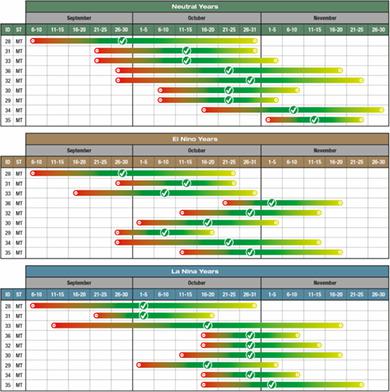当前位置:
X-MOL 学术
›
Int. J. Climatol.
›
论文详情
Our official English website, www.x-mol.net, welcomes your feedback! (Note: you will need to create a separate account there.)
The impact of El Niño Southern Oscillation on cropping season rainfall variability across Central Brazil
International Journal of Climatology ( IF 3.9 ) Pub Date : 2020-05-29 , DOI: 10.1002/joc.6684 Alexandre Bryan Heinemann 1 , Julian Ramirez‐Villegas 2, 3 , Luís Fernando Stone 1 , Ana Paula Garcia Abreu Silva 4 , David Henriques da Matta 4 , Mario Ernesto Piscoya Diaz 4
International Journal of Climatology ( IF 3.9 ) Pub Date : 2020-05-29 , DOI: 10.1002/joc.6684 Alexandre Bryan Heinemann 1 , Julian Ramirez‐Villegas 2, 3 , Luís Fernando Stone 1 , Ana Paula Garcia Abreu Silva 4 , David Henriques da Matta 4 , Mario Ernesto Piscoya Diaz 4
Affiliation

|
Local‐level understanding of within‐season rainfall variability and its relationship with the El Niño Southern Oscillation (ENSO) can shed light on crop yield variations and establish appropriate cropping calendars in rainfed systems. This requires information on the growing season, including its length, the total rainfall, the onset and cessation of rainfall, the number of wet and dry days, and the optimal sowing window. The objective of this study was to examine the onset and cessation of both the rainy and growing seasons using historical daily rainfall datasets (1980–2013) from 50 weather stations distributed across the main grain production region of Brazil. We then correlated the interannual variability of the climate variables and crop water availability with ENSO (using the Oceanic Niño Index, ONI). Across the study region, the onset of the rainy period ranged from late September to early November, and the cessation period ranged from late March to mid‐April. The onset of the growing season followed that of the rainy season, beginning across central and northern Mato Grosso in mid‐October, followed by Goiás and Tocantins, and finally Rondônia by the end of October. The length of the sowing window was reduced, and the mean optimal sowing date was delayed during La Niña years for most weather stations in the study region. Our results infer the need to adjust the cropping calendars for specific ENSO phases only in regions that conduct crop rotations. Based on rice crop model simulations of water availability, we propose a mean optimal crop sowing calendar for annual crops in Central Brazil.
中文翻译:

厄尔尼诺南部涛动对巴西中部整个种植季节降雨变异性的影响
当地对季节内降雨变化及其与厄尔尼诺南方涛动(ENSO)的关系的了解可以揭示作物产量的变化,并在雨养系统中建立适当的作物日历。这就需要有关生长季节的信息,包括其长度,总降雨,降雨的开始和停止,干湿天数以及最佳播种期。这项研究的目的是使用分布在巴西主要粮食产区的50个气象站的历史日降水量数据集(1980-2013年)来检查雨季和生长期的起止。然后,我们将ENSO的气候变量和作物可用水量的年际变率关联起来(使用大洋Niño指数,ONI)。在整个研究区域,雨季的开始时间从9月下旬到11月初,停止时间从3月下旬到4月中旬。生长季节的开始跟雨季的开始一样,从十月中旬开始横穿马托格罗索州中部和北部,随后是戈亚斯和托坎丁斯,最后是十月底的朗多尼亚。在研究区域的大多数气象站,拉尼娜年期间播种窗口的长度缩短了,平均最佳播种日期也被推迟了。我们的结果表明,只有在进行轮作的区域中,才需要针对特定ENSO阶段调整播种日历。基于水稻水分利用的作物模型模拟,我们提出了巴西中部一年生作物的平均最佳播种日历。停止时间从3月下旬到4月中旬。生长季节的开始跟雨季的开始一样,从十月中旬开始横穿马托格罗索州中部和北部,随后是戈亚斯和托坎丁斯,最后是十月底的朗多尼亚。在研究区域的大多数气象站,拉尼娜年期间播种窗口的长度缩短了,平均最佳播种日期也被推迟了。我们的结果表明,只有在进行轮作的区域中,才需要针对特定ENSO阶段调整播种日历。基于水稻水分利用的作物模型模拟,我们提出了巴西中部一年生作物的平均最佳播种日历。停止时间从3月下旬到4月中旬。生长季节的开始跟雨季的开始一样,从十月中旬开始横穿马托格罗索州中部和北部,随后是戈亚斯和托坎丁斯,最后是十月底的朗多尼亚。在研究区域的大多数气象站,拉尼娜年期间播种窗口的长度缩短了,平均最佳播种日期也被推迟了。我们的结果表明,只有在进行轮作的区域中,才需要针对特定ENSO阶段调整播种日历。基于水稻水分利用的作物模型模拟,我们提出了巴西中部一年生作物的平均最佳播种日历。10月中旬开始穿越马托格罗索州中部和北部,随后是戈亚斯(Goiás)和托坎丁斯(Tocantins),最后是十月底的朗多尼亚(Rondônia)。在研究区域的大多数气象站,拉尼娜年期间播种窗口的长度缩短了,平均最佳播种日期也被推迟了。我们的结果表明,只有在进行轮作的区域中,才需要针对特定ENSO阶段调整播种日历。基于水稻水分利用的作物模型模拟,我们提出了巴西中部一年生作物的平均最佳播种日历。10月中旬开始穿越马托格罗索州中部和北部,随后是戈亚斯(Goiás)和托坎丁(Tocantins),最后是十月底的朗多尼亚(Rondônia)。在研究区域的大多数气象站,拉尼娜年期间播种窗口的长度缩短了,平均最佳播种日期也被推迟了。我们的结果表明,只有在进行轮作的区域中,才需要针对特定ENSO阶段调整播种日历。基于水稻水分利用的作物模型模拟,我们提出了巴西中部一年生作物的平均最佳播种日历。我们的结果表明,只有在进行轮作的区域中,才需要针对特定ENSO阶段调整播种日历。基于水稻水分利用的作物模型模拟,我们提出了巴西中部一年生作物的平均最佳播种日历。我们的结果表明,仅在进行轮作的区域中需要针对特定ENSO阶段调整播种日历。基于水稻水分利用的作物模型模拟,我们提出了巴西中部一年生作物的平均最佳播种日历。
更新日期:2020-05-29
中文翻译:

厄尔尼诺南部涛动对巴西中部整个种植季节降雨变异性的影响
当地对季节内降雨变化及其与厄尔尼诺南方涛动(ENSO)的关系的了解可以揭示作物产量的变化,并在雨养系统中建立适当的作物日历。这就需要有关生长季节的信息,包括其长度,总降雨,降雨的开始和停止,干湿天数以及最佳播种期。这项研究的目的是使用分布在巴西主要粮食产区的50个气象站的历史日降水量数据集(1980-2013年)来检查雨季和生长期的起止。然后,我们将ENSO的气候变量和作物可用水量的年际变率关联起来(使用大洋Niño指数,ONI)。在整个研究区域,雨季的开始时间从9月下旬到11月初,停止时间从3月下旬到4月中旬。生长季节的开始跟雨季的开始一样,从十月中旬开始横穿马托格罗索州中部和北部,随后是戈亚斯和托坎丁斯,最后是十月底的朗多尼亚。在研究区域的大多数气象站,拉尼娜年期间播种窗口的长度缩短了,平均最佳播种日期也被推迟了。我们的结果表明,只有在进行轮作的区域中,才需要针对特定ENSO阶段调整播种日历。基于水稻水分利用的作物模型模拟,我们提出了巴西中部一年生作物的平均最佳播种日历。停止时间从3月下旬到4月中旬。生长季节的开始跟雨季的开始一样,从十月中旬开始横穿马托格罗索州中部和北部,随后是戈亚斯和托坎丁斯,最后是十月底的朗多尼亚。在研究区域的大多数气象站,拉尼娜年期间播种窗口的长度缩短了,平均最佳播种日期也被推迟了。我们的结果表明,只有在进行轮作的区域中,才需要针对特定ENSO阶段调整播种日历。基于水稻水分利用的作物模型模拟,我们提出了巴西中部一年生作物的平均最佳播种日历。停止时间从3月下旬到4月中旬。生长季节的开始跟雨季的开始一样,从十月中旬开始横穿马托格罗索州中部和北部,随后是戈亚斯和托坎丁斯,最后是十月底的朗多尼亚。在研究区域的大多数气象站,拉尼娜年期间播种窗口的长度缩短了,平均最佳播种日期也被推迟了。我们的结果表明,只有在进行轮作的区域中,才需要针对特定ENSO阶段调整播种日历。基于水稻水分利用的作物模型模拟,我们提出了巴西中部一年生作物的平均最佳播种日历。10月中旬开始穿越马托格罗索州中部和北部,随后是戈亚斯(Goiás)和托坎丁斯(Tocantins),最后是十月底的朗多尼亚(Rondônia)。在研究区域的大多数气象站,拉尼娜年期间播种窗口的长度缩短了,平均最佳播种日期也被推迟了。我们的结果表明,只有在进行轮作的区域中,才需要针对特定ENSO阶段调整播种日历。基于水稻水分利用的作物模型模拟,我们提出了巴西中部一年生作物的平均最佳播种日历。10月中旬开始穿越马托格罗索州中部和北部,随后是戈亚斯(Goiás)和托坎丁(Tocantins),最后是十月底的朗多尼亚(Rondônia)。在研究区域的大多数气象站,拉尼娜年期间播种窗口的长度缩短了,平均最佳播种日期也被推迟了。我们的结果表明,只有在进行轮作的区域中,才需要针对特定ENSO阶段调整播种日历。基于水稻水分利用的作物模型模拟,我们提出了巴西中部一年生作物的平均最佳播种日历。我们的结果表明,只有在进行轮作的区域中,才需要针对特定ENSO阶段调整播种日历。基于水稻水分利用的作物模型模拟,我们提出了巴西中部一年生作物的平均最佳播种日历。我们的结果表明,仅在进行轮作的区域中需要针对特定ENSO阶段调整播种日历。基于水稻水分利用的作物模型模拟,我们提出了巴西中部一年生作物的平均最佳播种日历。


























 京公网安备 11010802027423号
京公网安备 11010802027423号